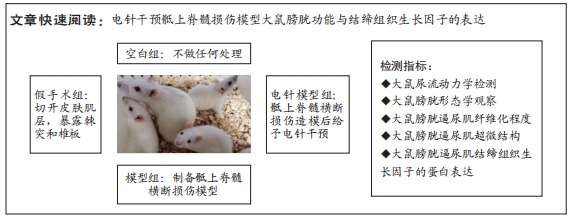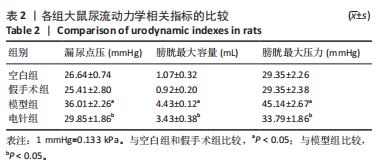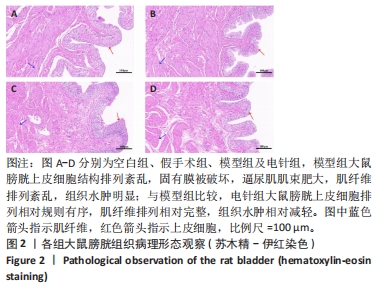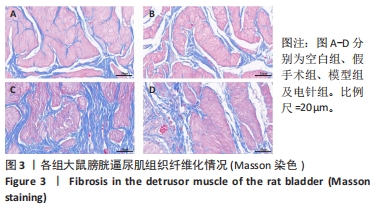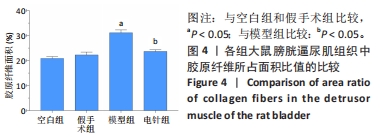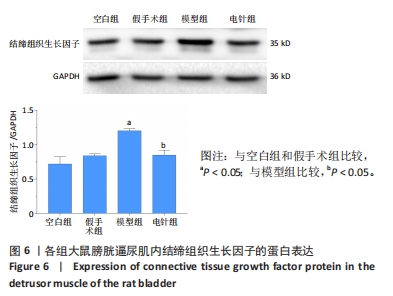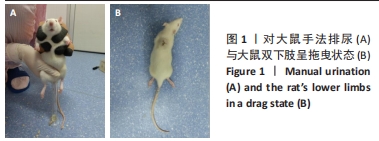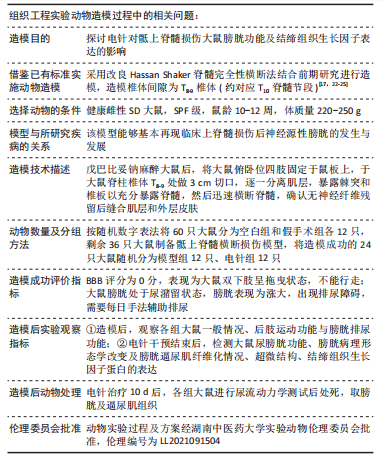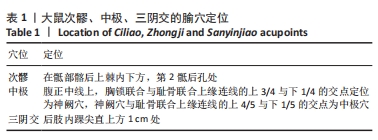[1] XU H, ZHAO W, ZHOU Y, et al. Multi-omics in Spinal Cord Injury: Diagnosis, Prognosis, and Treatment. Cell Mol Biol (Noisy-le-grand). 2022;68(11):58-70.
[2] HU X, XU W, REN Y, et al. Spinal cord injury: molecular mechanisms and therapeutic interventions. Signal Transduc Target Ther. 2023;8(1):245.
[3] 胥少汀,郭世绂,陈懿.脊髓损伤基础与临床[M].北京:解放军北京军区总医院,2009.
[4] JOSHI AD, SHUKLA A, CHAWATHE V, et al. Clean intermittent catheterization in long-term management of neurogenic bladder in spinal cord injury: Patient perspective and experiences. Int J Urol. 2022;29(4):317-323.
[5] CHEN PC, LEE KH, LEE WC, et al. Treating Neurogenic Lower Urinary Tract Dysfunction in Chronic Spinal Cord Injury Patients-When Intravesical Botox Injection or Urethral Botox Injection Are Indicated. Toxins (Basel). 2023;15(4):288.
[6] HAMID R, AVERBECK MA, CHIANG H, et al. Epidemiology and pathophysiology of neurogenic bladder after spinal cord injury. World J Urol. 2018;36(10):1517-1527.
[7] KIM SJ, KIM J, NA YG, et al.Irreversible Bladder Remodeling Induced by Fibrosis. Int Neurourol J. 2021;25(Suppl 1):S3-S7.
[8] DEVEAUD CM, MACARAK EJ, KUCICH U, et al. Molecular analysis of collagens in bladder fibrosis. J Urol. 1998;160(4):1518-1527.
[9] AZADZOI KM, CHEN BG, RADISAVLJEVIC ZM, et al. Molecular reactions and ultrastructural damage in the chronically ischemic bladder. J Urol. 2011;186(5):2115-2122.
[10] BRADHAM DM, IGARASHI A, POTTER RL, et al. Connective tissue growth factor: a cysteine-rich mitogen secreted by human vascular endothelial cells is related to the SRC-induced immediate early gene product CEF-10. J Cell Biol. 1991;114(6):1285-1294.
[11] LIN F, YUAN Y, YE X, et al. Characterization and role of connective tissue growth factor gene in collagen synthesis in swim bladder of chu’s croaker (Nibea coibor). Int J Biol Macromol. 2023;227:1336-1345.
[12] TRAMPUŽ SR, VAN RIET S, NORDLING Å, et al.The Role of CTGF in Liver Fibrosis Induced in 3D Human Liver Spheroids. Cells. 2023;12(2):302.
[13] MILLER CA, KENNELLY MJ. Pulse article:survey of neurogenic bladder management in spinal cord injury patients around the world. Spinal Cord Ser Cases. 2021;7(1):16.
[14] 王美玲.基于清洁间歇导尿术的自我护理在脊髓损伤后神经源性膀胱患者中的应用效果分析[J].中西医结合心血管病电子杂志, 2020,8(19):87,143.
[15] PEREZ NE, GODBOLE NP, AMIN K, et al. Neurogenic Bladder Physiology, Pathogenesis,and Management after Spinal Cord Injury. J Pers Med. 2022;12(6):968.
[16] 张胜利,赵承奇,李勇.中医综合康复治疗对脊髓损伤后神经源性膀胱尿潴留患者生活质量的改善效果分析[J].中国实用医药,2020, 15(11):141-142.
[17] AI K, LIU Q, XU M, et al. Effect of electroacupuncture on urodynamics of neurogenic bladder and PACAP/cAMP/PKA signaling pathway in detrusor tissue of rats after suprasacral spinal cord injury. Zhen Ci Yan Jiu. 2021;46(9):728-734.
[18] ZHANG HT, NONG QP, WEI L, et al. Effect of thunder-fire moxibustion combined with electroacupuncture on urodynamics in patients with neurogenic bladder after spinal cord injury. Zhen Ci Yan Jiu. 2021; 46(11):958-962.
[19] 卓越,艾坤,许明,等.电针对骶上脊髓损伤后大鼠神经源性膀胱及血清外泌体miRNA差异表达的影响[J].中国康复医学杂志,2023, 38(5):577-588.
[20] 张海涛,韦秋连,韦林,等.雷火灸结合电针治疗骶上脊髓损伤后神经源性膀胱的临床观察[J].中国医药导报,2020,17(28):129-132.
[21] 许明,刘琼,邓石峰,等.基于PACAP-cAMP信号通路研究电针治疗骶上脊髓损伤后逼尿肌反射亢进型膀胱的效应机制[J].世界针灸杂志(英文版),2023,33(3):273-281.
[22] 吕山河,胡碧浓,黄梓铭,等.电针对骶上脊髓损伤大鼠膀胱尿流动力学和逼尿肌肌电图振幅的影响[J].湖南中医药大学学报,2020, 40(11):1355-1360.
[23] 卓越,许明,邓石峰,等.大鼠骶上不同节段脊髓损伤后神经源性膀胱模型比较及尿流动力学分析[J].湖南中医药大学学报,2022, 42(9):1426-1433.
[24] 张雨辰,张泓,艾坤,等.大鼠脊髓损伤后神经源性膀胱模型的制备[J].中国康复医学杂志,2014,29(6):542-546.
[25] SHAKER H, MOURAD MS, ELBIALY MH, et al. Urinary bladder hyperreflexia: a rat animal model. Neurourol Urodyn. 2003;22(7): 693-698.
[26] SHEA VK, CAI R, CREPPS B, et al. Sensory fibers of the pelvic nerve innervating the Rat’s urinary bladder. J Neurophysiol. 2000;84(4): 1924-1933.
[27] 李邦伟,周传龙,王超,等.方剑乔教授针灸治疗术后尿潴留经验探析[J].浙江中医药大学学报,2022,46(8):835-838.
[28] LONG ZL, LIU ZS. Brief analysis on main indications and compatibility rules of Ciliao (BL 32) based on data mining. Zhongguo Zhen Jiu. 2022; 42(4):459-463.
[29] 汪汐,龙子临,何欣,等.基于数据挖掘分析针灸改善宫颈癌术后尿潴留的选穴规律[J].针灸临床杂志,2022,38(11):39-43.
[30] 孙燕,钟亮,陶林花,等.高压氧联合电针八髎穴对脊髓损伤神经源性膀胱患者尿动力学的影响[J].中国康复,2023,38(7):422-425.
[31] 李慧,徐利飞.电针八髎穴联合康复治疗脊损伤患者神经源性膀胱的临床研究[J].湖北中医杂志,2023,45(7):39-41.
[32] 耿丹,钟丹.电针关元穴治疗脊髓损伤患者逼尿肌反射亢进的疗效分析[J].中国社区医师,2017,33(6):57-59.
[33] 韩鹏,付渊博,杨友信,等.基于数据挖掘技术探究针灸治疗脊髓损伤后神经源性膀胱选穴规律[J].中国中医药信息杂志,2022, 29(2):10-14.
[34] 居诗如,尹晶,胡飞,等.电针不同穴位对脊髓损伤后神经源性膀胱大鼠作用的机制研究[J].湖北中医药大学学报,2020,22(4):10-13.
[35] YU P, GAO B, XIA Y. Meta analysis of the effect of distal or local point selection on acupuncture efficacy. World J Acupunct Moxibustion. 2018;28(2):114-120.
[36] WYNDAELE JJ. Investigation of the afferent nerves of the lowerurinary tract in patients with complete and incomplete spinal cord injury. Spinal Cord. 1991;29(7):490-494.
[37] CHENG PT, WONG MK, CHANG PL. A therapeutic trial of acupuncture in neurogenic bladder of spinal cord injured patients--a preliminary report. Spinal Cord. 1998;36(7):476-480.
[38] 韦慧麟,任亚锋,张芝兰,等.电针和艾灸治疗脊髓损伤后神经源性膀胱疗效差异:随机对照试验[J/OL].中国针灸:1-7[2023-08-10].doi:10.13703/j.0255-2930.20221027-k0005.
[39] 郭宁.电针“中极”“关元”穴对骶上脊髓损伤后神经源性膀胱大鼠膀胱功能的影响及机制研究[D].郑州:河南中医药大学,2022.
[40] CHANG S, MAO ST, HU SJ, et al. Studies of detrusor-sphincter synergia and dyssynergia during micturition in rats via fractional Brownian motion. IEEE Trans Biomed Eng. 2000;47(8):1066-1073.
[41] 马源.脊髓损伤引起神经源性膀胱对膀胱-肾脏结构功能变化的影响[D].郑州:郑州大学,2021.
[42] BUSHNELL JY, CATES LN, HYDE JE, et al. Early Detrusor Application of Botulinum Toxin A Results in Reduced Bladder Hypertrophy and Fibrosis after Spinal Cord Injury in a Rodent Model. Toxins (Basel). 2022;14(11):777.
[43] JHANG JF, JIANG YH, HSU YH, et al. Pathogenesis evidence from human and animal models of detrusor underactivity. Tzu Chi Med J. 2021;34(3):287-296.
[44] 刘倩,王军锋,马楠,等.结缔组织生长因子在神经源性膀胱纤维化过程中的影响因素研究[J].中华小儿外科杂志,2018,39(7): 539-545.
[45] REBOLLEDO DL, LIPSON KE, BRANDAN E. Driving fibrosis in neuromuscular diseases: Role and regulation of Connective tissue growth factor (CCN2/CTGF). Matrix Biol Plus. 2021;11:100059.
[46] SHIEH JM, TSAI YJ, CHI JC, et al. TGFβ mediates collagen production in human CRSsNP nasal mucosa-derived fibroblasts through Smad2/3-dependent pathway and CTGF induction and secretion. J Cell Physiol. 2019;234(7):10489-10499.
[47] 宋晨,诸靖宇,吴金星,等.骶3神经电调节对脊髓损伤早期大鼠逼尿肌细胞凋亡及膀胱纤维化影响的实验研究[J].浙江中西医结合杂志,2015,25(5):439-442,529.
|
